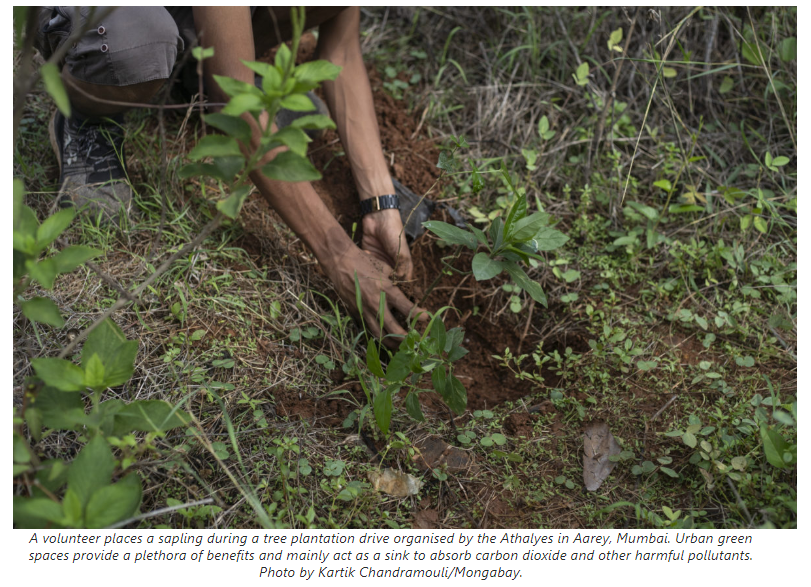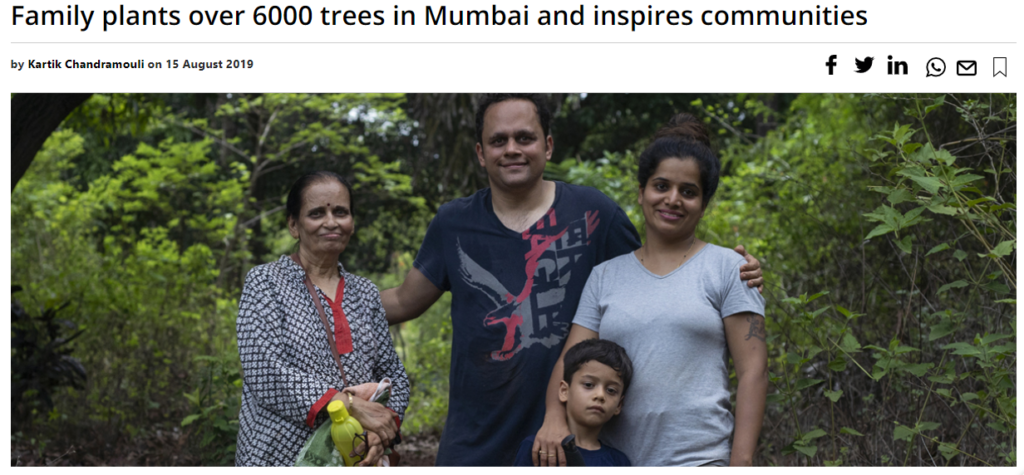MONGABAY
Can the Indian film industry call lights, camera, climate action?
Biswajeet Bora’s 2015 Hindi feature film Aisa Yeh Jahaan not only showcased the alienation of urban denizens from nature but also demonstrated that even the film industry can take action to tackle climate change.
The film was India’s first carbon-neutral film. Bora’s desire to make such a film, together with the work of the Centre for Environmental Research and Education (CERE), made the initial inspiration a reality.
The Mumbai-based CERE, a firm that specialises in environmental sustainability, analysed every activity of the film’s production and pre-production (the planning stages before a film shoot) through the environmental lens. The film’s carbon footprint – the amount of greenhouse gas emissions – was calculated by factoring transportation of people and equipment by air and road, catering, set construction, hotels, and so on.
CERE used scientifically determined emission factors for each activity and calculated the film’s emission as 78.47 metric tonnes of carbon dioxide equivalent (MtCO2e).
With these calculations, the idea was to remove the same amount of carbon produced in making the film, from the atmosphere. CERE recommended offsetting the emissions by planting 560 indigenous trees of a mixed variety. The plantation was done in parts of Mumbai and Assam, where the film was shot, for under a fraction of the film’s budget. The trees were geotagged and monitored for three years as part of CERE’s Urban Afforestation Project.
And so, in 2015, Aisa Yeh Jahaan became India’s first carbon-neutral full-length feature film.
Janjri Jasani, head of sustainability services at CERE, said, “Film and television is a resource-intensive industry. It should use resources efficiently to reduce footprint. Offset when you cannot.”
CERE pitched the idea of a ‘Carbon Neutral Film Certification’ to many other production houses. Unfortunately, one more project later, things didn’t move beyond the pilot. Jasani said, “Production houses may have balked at the cost of offsetting or just not have known enough about the subject (climate change and carbon footprint) to take on this challenge. Given the lack of interest at the time, CERE scaled down its focus.”

Siddharth Nakai, a sustainability consultant with a television network and founder of Greening Advertising Media and Entertainment (GAME), said, “There are straight guidelines and environmental laws for industries. The film and media industry is not seen as a carbon-intensive industry like a manufacturing plant, but it can have a substantial environmental impact because its energy and fuel consumption are at different stages.”
He too admits that it has been tough to make a breakthrough and bag projects that are looking to become sustainable. But he sees mindsets and convenience as the villain here, not money.
Nakai says that the entire process of film pre-production, production, and post-production (e.g., audio/video editing) can work with some guidelines. “For example, in the pre-production stage, one could use eco-fonts to print scripts and documents. These fonts use less ink and save cartridges. On film sets, rechargeable batteries can be used for audio equipment. That saves a considerable amount of use-and-throw batteries that end up at the landfill and make the environment toxic. Waste segregation and zero-plastic bottles on sets are totally possible. These are small things, but gradually, they save a lot of costs.”
Zooming out to the bigger picture, sustainable practices could reduce the environmental impact of film production, which, among other things, uses energy, generates waste, and burn fossil fuels through transportation.
Unrecycled solid and electronic waste at landfills break down and contribute to methane emissions, which is a more potent greenhouse gas as compared to carbon dioxide. The waste sector contributed to three percent of India’s total GHG emissions in 2014.
A 2006 UCLA study found that the US film and television industry created 15 million tons of carbon dioxide in 1999.
Another challenge to making a process such as a film production sustainable is that production can be scattered across long periods and locations. So, it needs the continuous monitoring and support of all stakeholders involved. Nakai recollected, “I’ve once huddled the entire crew…actors, director, workers on set…and explained the rules and the reasons. But if someone decides not to follow something like waste segregation, the effort collapses.”
Efforts to make films production sustainable
There are other ways film productions are trying to make an impact, or rather, reduce it. Cut to Vectar Project, a film-studio in Manchester, United Kingdom that is dedicated to achieving “zero impact filming”. It boasts of an LED-only light setup powered by solar and will build virtual sets with augmented reality to avoid building a physical set. Another proposition is to use an 8K 3D camera setup, which will allow clients and even filmmakers to skip road or air travel to the studio.
A Mexican documentary film Bosque de Niebla (2018) became carbon neutral by compensating its emissions using United Nations-certified carbon reduction credits that allowed the production unit to support solutions against climate change across developing countries.
Vivek Gilani, the founder of CBalance, a Mumbai-based company that helps organisations manage their carbon footprints, expressed concern that there’s a risk of greenwashing in the process. And if someone sincerely takes up the task, he said, “Instead of focusing on every frivolous aspect (of the film production), we can identify the carbon hotspots and work to reduce those.”
Gilani, who is developing the first India-specific GHG emission factor database and hasn’t consulted on film projects, said, “Like how a film production is seen through the lens of other government permissions, actor A or actor B, location A or B, environmental impact and climate change should be a lens too. But first, evaluating the footprint has to be seen as part of the solution.”

Jasani concurred that producers are free to offset emissions in the way they like, but the industry accounting its carbon footprint is essential. She said, “Offsetting with trees is a slow process and can take over 15 years to achieve. It has to be done on degraded land and forests and not habitats like grasslands. Tree planting is not the solution for all environmental issues, but they provide a lot of other ecological services.”
As the entertainment industry is projected to grow in India, its resulting emissions and waste are bound to rise too. Gilani said, “The industry should recognise and declare the issue.” He hopes that climate change soon finds its place in film scripts, even if it is not the story. “Someone in the film can maybe miss a flight because of an extreme weather event,” he joked.
There are faces in the film industry who are vocal about environmental issues, and Jasani believes it would be encouraging if they speak up and have conversations about its impact.
by Kartik Chandramouli on 1 January 2020 ( https://india.mongabay.com/2020/01/can-the-indian-film-industry-call-lights-camera-climate-action/ )
Reference – https://india.mongabay.com/2019/08/family-plants-over-6000-trees-in-mumbai-and-inspires-communities/
- The Athalye family is continuing a tradition that spans two decades and three generations: of planting native trees and shrubs to make densely populated suburban Mumbai greener and healthier.
- The family has planted around 6000 saplings and also setup a butterfly park in Aarey.
- Their actions inspire many and could contribute to building up the coastal city’s green spaces and climate resilience.
- On Independence Day we bring you this inspirational story for a family’s efforts to add green to the Maximum City.
The high noon sun makes it tough to inspect the shrubs and plants in the butterfly park without squinting. Despite the harsh conditions, the Athalye family – Sandeep, his wife, son, and mother – arrived at the two-acre park for their regular visit, not just to have a leisurely time, but to survey the thriving Eden they helped establish inside Mumbai’s green lung: the roughly 3000-acre Aarey Milk Colony.
The Athalye family’s weekend trip to Aarey, adjacent to a congested highway in the heart of the city, is sacrosanct. It is unique because they were continuing a deeply rooted tree-planting family tradition.
It all started when Sandeep’s father, Vinay Athalye, who used to take regular leisurely walks at Aarey, decided to plant around 100 saplings in 2000. Driven by passion and support from his fellow walkers and family, the elder Athalye managed to plant around 5500 saplings in Aarey over 15 years.
But it isn’t just any kind of tree saplings that he planted. Based on traditional knowledge, Athalye purposefully planted five native tree species: peepal (sacred fig/Ficus religiosa), vad (banyan/Ficus benghalensis), amla (Indian gooseberry/Phyllanthus emblica), bael (Aegle marmelos) and ashoka (Saraca asoca) that are collectively called panchavati (grove of five trees). Through the years, he also added 550 saplings of these native trees to a patch of land that grew into a densely wooded area and was later publicly known as Panchavati as well. “These tree species, planted together in specific directions, are believed to increase oxygen in the atmosphere,” said Sandeep, displaying his father’s compiled notes about tree plantations. Though the land was later allotted to one of Mumbai’s defence forces and became restricted to the public, Athalye was known for this deed.
After his father’s demise in 2015, Sandeep’s family continued the tradition of greening the city, having planted approximately 700 saplings of native species to date. To fulfil the senior Athalye’s wish, the family also planted 1200 shrubs and converted another barren plot into a bustling butterfly garden. “We must give back to nature,” said 39-year-old Sandeep.

Green and open spaces are a rarity in this densely populated megacity of over 12.4 million.
Rashneh Pardiwala, ecologist and founder of the Centre for Environmental Research & Education (CERE), explained, “One of the areas of concern in India is the diminishing availability of green spaces in our major metros. Today, Mumbai, for example, has just 1.1 square metres of open space per person, including Sanjay Gandhi National Park, gardens, recreation grounds, and playgrounds.”
Mumbai falls short of World Health Organisation’s (WHO) recommendation of nine square metre green open spaces by almost nine times.
The Environment Status Report (ESR) 2017-18 conducted by the governing civic body of Mumbai, Brihanmumbai Municipal Corporation (BMC), revealed that the city has one tree for every four people – an insignificant number compared to the eight trees per person recommended by a study by the Indian Institute of Science (IISc), Bengaluru.
Further, a recent study by the Indian Institute of Technology (IIT)-Bombay highlighted how people from lower socio-economic backgrounds have less access to green spaces in Mumbai. Ronita Bardhan, a co-author of the study and assistant professor at the Centre for Urban Science & Engineering at IIT-Bombay, said, “Urban green spaces are loosely defined in Mumbai as compared to cities such as London and Singapore. These places should be accessible as well as safe for people. Our cities need a green audit to understand the health of these spaces and to decide what needs protection or restoration.”
Many studies have demonstrated that coastal cities such as Mumbai are highly vulnerable to the impacts of climate change. And green spaces are a crucial part of urban infrastructure.
Trees aid in carbon sequestration i.e. they act as a sink by absorbing carbon dioxide (CO2) from the atmosphere and release oxygen (O2) in the process. The increase in the amount of CO2 due to anthropogenic reasons is one of the leading causes of climate change. A recent study claims a natural solution to mitigate this: plant a trillion trees in specific regions of the world to capture 25% of CO2.

“A single mature tree can absorb about 20 kg of CO2 per year, which equals to emissions from driving over 80 km in a passenger car,” said Pardiwala.
CERE has planted 46,557 large native trees across 61 locations, including many sites in Mumbai under its Urban Afforestation Project (UAP). The initiative helps companies, organisations, and individuals to reduce their carbon footprint and has sequestered 12,602 metric tonnes of CO2.
The benefits of a green cover branch in several directions. It regulates the local climate and reduces the urban heat island effect caused by heat trapped between the artificial structures of the city. Urban trees also play a crucial role in reducing air pollution as the leaves absorb harmful pollutants rising from vehicles, industries, and other sources.
Green spaces in urban areas provide shelter to local biodiversity, act as sound and wind barriers and contribute to the social, mental, and physical well-being of people – the list goes on.
Fortunately, the barren plot where the second-generation Athalyes established a butterfly park is at present free for all to access and enjoy. A kaleidoscope of butterflies might welcome visitors who enter the garden. Aarey has recorded 86 butterflies species, and Sandeep is hopeful to shelter them here.
The Athalyes have never been alone in the journey though. The senior Athalye was supported by his walking partners and received donations from individuals and other communities who were inspired by his efforts. Sandeep continues to receive funds from many of them and has added other corporates, NGOs, communities, and individuals to his band of funders.

But his idea doesn’t end with planting a sapling. He invites volunteers to the plantation drives and makes them aware of the benefits of planting indigenous trees and hopes to give them experience and get inspired. “They should not just become opportunities for selfies,” he said. “Once you plant a sapling, you have to monitor it like a baby for the first few years.”
A recent drive in a roughly three-acre plot of land which opened up to a view of Mumbai’s skyscrapers at the horizon pleasantly surprised Sandeep. He expected around 100 to 150 people to attend and plant 300 peepal saplings but 400 – 500 people turned up.
Sandeep is relieved that his six-year-old son gets the chance to get his hands dirty in the soil, acknowledging the alienation of several urban residents from the environment. He believes it will help him form a bond with nature and become sensitive to its issues.
India pledged to reduce its national emissions by creating an additional carbon sink for 2.5 to 3 billion tonnes of CO2 equivalent through additional forest and tree cover by 2030. Mumbai, like many other cities in India, bears witness to rapid urban infrastructure projects, mostly at a disproportionate environmental cost. At such a time, the efforts of individuals and communities to safeguard or revive existing ecosystems and create new ones can be crucial.
“There are three types of people: one who damage the environment, those who watch the damage happening and comment on it. I want to be in the third category who do whatever they can to protect the environment,” said Sandeep.

